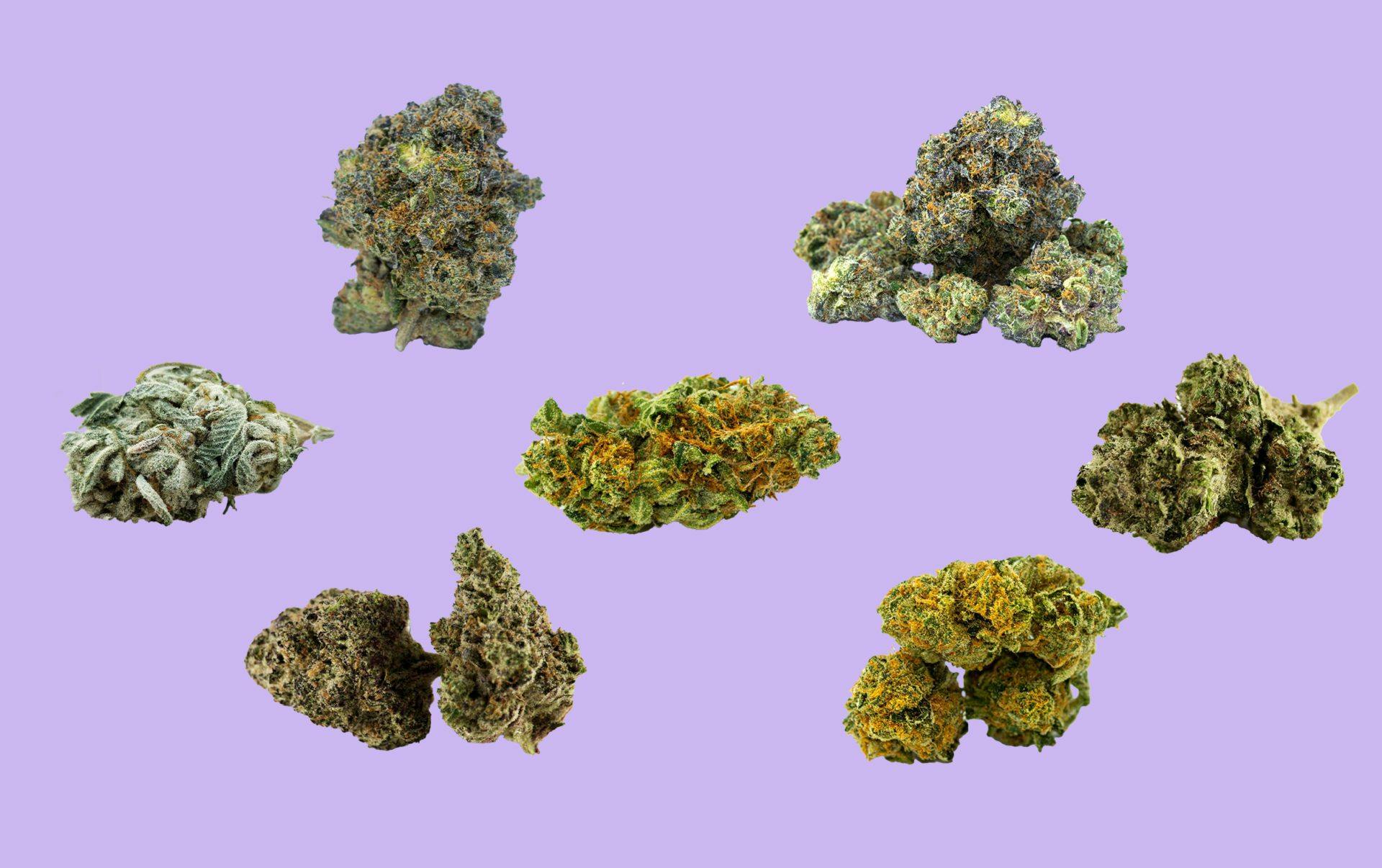Everything You Need to Know About Marijuana Strains

Article written by

Tina MagrabiSenior Content Writer
Content reviewed by

Dr. Lewis JasseyMedical Director - Pediatric Medicine
Marijuana strains offer variety and novelty to medical cannabis users. Strains come in different flavors, aromas, and levels of potency. From a botanical standpoint, marijuana strains are the ancestors of specific cannabis plants. The lineage of a marijuana strain lends insight into the strain’s unique effects and benefits.
However, the term “strain” is not considered a valid name today, with many preferring “cultivars” or “chemovars.” As people understand the word “strain” due to widespread use, we will use “strain” throughout this article.
Learn more about the botanical science behind marijuana strains, how new strains are created, and how to find the right strain for you.
Get your medical marijuana card
Connect with a licensed physician online in minutes.
What is a Marijuana Strain, Exactly?
A marijuana strain is a classification that determines a plant’s chemotype (chemical profile), phenotype (physical appearance), and potential medical effects. Cannabis strains are sometimes called cultivars, chemovars, chemotypes, or varieties.
Cannabis experts currently recognize between 700 and 800 strains, but there could be thousands of undiscovered or obscure strains that have yet to make the list. There is no limit to how many cannabis strains can evolve as cultivators mix and match different plants to produce an array of choices for users.
How New Strains Are Created
Cannabis cultivators create new strains by breeding male and female plants and crossing two to form a hybrid. Girl Scout Cookies (GSC) is the offspring of OG Kush and Durban Poison. Crossing Blueberry with White Widow will yield Berry White, a prime example of the eclectic creativity of naming cannabis strains.
New strains may also be discovered through botanical research and exploration.
Different Types of Marijuana Strains
The basic types of marijuana strains are Sativa, indica, and hybrid. Each strain has characteristic effects (such as energy-boosting or sleep-enhancing), but it’s crucial not to generalize. A strain’s effects largely depend on the person consuming the cannabis, and weight, overall health, and experience level all factor into how you respond to a particular strain.
Here are some general guidelines about Cannabis sativa, Cannabis indica, and hybrid cannabis strains.
Sativa
Sativa strains contain high levels of psychoactive tetrahydrocannabinol (THC) and are best known for their energizing effects. Tall with narrow leaves, Sativa plants produce fruity, floral, and spicy aromas and flavors depending on the terpenes present.
Indica
Indica strains sometimes contain less THC than Sativa strains and higher amounts of cannabidiol (CBD). These strains originate in the mountains of India and surrounding areas and are known for producing sedative effects.
Hybrid
Most cannabis strains are hybrids or a combination of sativa and indica. However, even most strains labeled “indica” or “sativa” are hybrids! The most reliable way to gauge the effects of a strain is by looking at its cannabinoid and terpene content rather than the sativa, indica, or hybrid label.
Hybrids can be higher in THC or CBD, depending on their chemotype. While sativa and indica strains may produce more reliable effects, the effects of hybrid strains are often variable.
How to Choose a Marijuana Strain
First, consider your level of experience with cannabis when you choose a marijuana strain. If you’re new to cannabis, start with a CBD-dominant strain with lower concentrations of THC so you won’t get too high. A strain with an 80:20 CBD:THC ratio is suitable for absolute beginners, while you might progress to a 50:50 or 1:1 ratio once you become more comfortable with the potent psychoactive cannabinoid.
Next, choose a strain according to the effects you wish to experience. If you need to unwind, try an indica-rich Blueberry to relax you. If you have an exam coming up, you might select Sativa-dominant Jack Herer to keep you alert.
In addition, consider other cannabinoids beyond CBD and THC. Cannabinol (CBN) produces relaxing effects, while tetrahydrocannabivarin (THCV) can temper THC and relieve anxiety simultaneously. Also, consider terpenes; myrcene, linalool, and pinene are known for helping you unwind.
Finally, consider your preferences for flavors and aromas. Pineapple OG can feel like a tropical vacation, while Gelato could transport you to an ice cream parlor in Italy.
As with all cannabis purchases, be sure to obtain your strains from a licensed dispensary (or cultivate them yourself — many states allow medical cannabis patients to grow their own medicine). Scan the list of ingredients, lab test results, and other key quality indicators. If you have a medical marijuana prescription, carefully follow dosage instructions to get the most out of your cannabis strain safely.
Most Popular Marijuana Strains
New strains constantly emerge, with cultivators blending established varieties into original hybrids. However, some tried and true strains are perennial hot sellers in dispensaries. Here are examples of five of the most popular marijuana strains available:
- Northern Lights: Indica strain with a pine sensory profile; commonly used to treat anxiety and insomnia
- Dutch Treat: Sativa strain high in CBD and extremely popular with medical users
- Sour Diesel: Not for amateurs, Sour Diesel is sky-high in THC and low in CBD; reportedly effective at treating pain
- Black Magic Kush: Deep in color and rich in the terpene pinene; it works its magic by helping many people drift off to sleep
- Amnesia Haze: Another strain that might send you into a deep sleep with its potent tranquilizing effects
These are just a handful of the most popular marijuana strains on the market. OG Kush, Blue Dream, LA Confidential, and Granddaddy Purple are countless other bestselling strains people turn to for medicinal and recreational purposes.
What is the Best Marijuana Strain?
The best marijuana strain ultimately depends on your personal health goals and any medical conditions you seek to treat. Some marijuana strains are better at treating anxiety, while others may help people with chronic pain.
Medical marijuana has numerous flavors, aromas, psychoactive effects, and therapeutic benefits. The best way to discover which strain works for you is to experiment with Sativas, indicas, and hybrids with different CBD:THC ratios and terpenes. The strains that become your favorite are the best strains for you! And you may have other favorites for different times of the day.
Get Your Medical Card
Connect with a licensed physician online in minutes.
Frequently Asked Questions
Why do marijuana strains have funny names?
The names of marijuana strains tell unique stories. Some weed strains are named after people, while others derive from specific places. Marijuana strain names may also be based on scent and flavor. The strain Girl Scout Cookies, for example, smells like fresh baked goods and tastes like the popular Thin Mints that troops sell each year. Other flavor-based names are more straightforward, like Lemon Meringue that has a distinctly tart citrus taste.
Some people will argue that strain names are pure marketing strategies that indicate nothing concrete. Furthermore, each person will react differently to a strain, meaning that you could find Blue Dream relaxing while someone else will find it uplifting.
What is the oldest marijuana strain available today?
As marijuana originated in Central Asia, it’s not surprising that many of the oldest strains are linked to this region. Among the oldest cannabis strains are Afghani, Hindu Kush, and Nepalese, and each of these strains connects to the Asian continent and ancient cannabis culture.
Can a marijuana strain make you higher than another?
Yes, different strains produce different effects, including the level of high you experience. Strains high in THC will invariably have more potent highs than those that are CBD-dominant.


